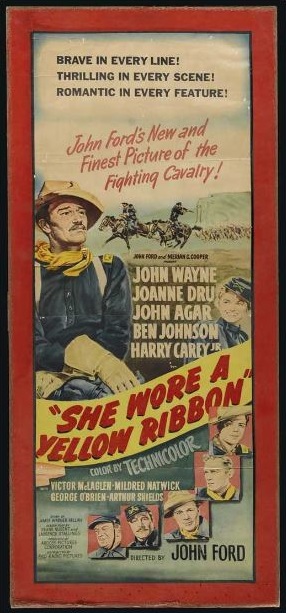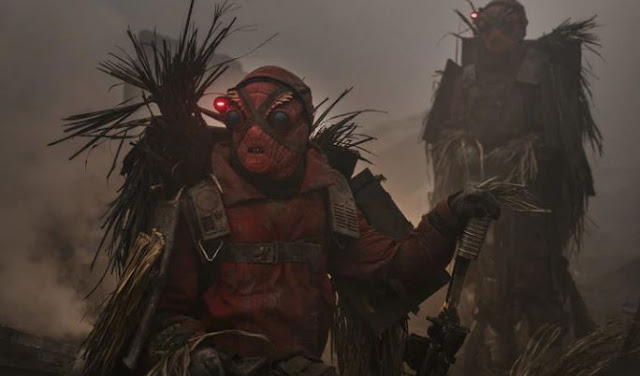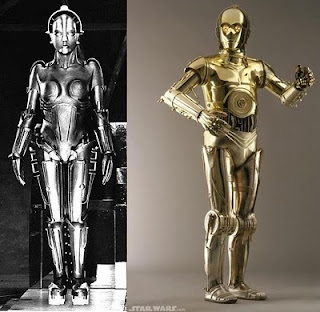SHE WORE A YELLOW RIBBON (1949)
She Wore a Yellow Ribbon (1949) is the second installment in the “Cavalry Trilogy” by legendary western film director John Ford. We already covered the first installment with Fort Apache (1948) and its connection to Star Wars: Episode IV – A New Hope (1977). Star Wars: The Magic of Myth book (published 1997) and Smithsonian exhibit mention all three films in the Cavalry Trilogy - mainly as inspiration for the character of Han Solo. Since Solo: A Star Wars Story (2018) is undeniably a space western (maybe even more than A New Hope), I thought it was time to revisit Ford’s Cavalry Trilogy and connect the influences between Ribbon and Solo.
Ribbon stars famed cowboy actors John Wayne (a.k.a “The Duke”) and Harry Carey Jr. alongside an impressive cast. The film won the Oscar for Best Color Cinematography in 1949. And, like Solo: A Star Wars Story, there was plenty of drama within the crew including a disagreement between Ribbon’s Director of Photography Winton Hoch and John Ford over all things – a rolling cloud landscape shot. But Ford got the shot and used it in the film. Hoch got the Oscar as DP. Here’s the trailer for She Wore a Yellow Ribbon…
Solo had so much promise as the back story to one of Star Wars’ most beloved characters, Han Solo. Before the film was finished, word was out that the production was in trouble. Lucasfilm fired original directors Phil Lord and Chris Miller (Spider-Man: Into the Spiderverse, The Lego Movie) due to “creative differences” (rumors were they were asking for 30+ takes per scene) and brought in acclaimed director Ron Howard (Pavarotti, Apollo 13) to finish the film. The result: a tight, fun ride that flopped at the Box Office. Some fans/critics felt Solo paid the price for the disruptive and fan-divisive Star Wars: The Last Jedi (2017). Others blame the switch in release dates (the new ‘sequel’ films and Rogue One had December release dates; Solo had a May 25th release date – having it come out less than a year before the last SW movie).
Regardless of all that off-screen drama, Solo delivers it’s promised cargo. We see a young Han (played quite well by Alden Ehreneich) and how he meets up with Chewie (Joonas Suotamo), Lando (Donald Glover) and the Millenium Falcon. There’s a good deal of old school Expanded Universe nods as well as tying in the Clone Wars TV series. It’s a franchise film that wonderfully employs details from various aspects of the franchise. Honestly, it’s my favorite Disney Star Wars film to date. Here’s the trailer:
ROOKIE vs. RETIREE
Solo opens with a young Han and his love Qi’ra (Emilia Clarke) trying to escape their miserable home planet. They get separated during their escape and the film focuses mainly on Han – signing up for the Imperial Academy, going AWOL from the Academy and his entrance into the criminal underworld. Ribbon highlights the end of the adventurous career of its main character Captain Nathan Brittles (John Wayne) – who is just days away from retiring from the United States Cavalry. There’s a lot of talk about “retiring” in Solo after a big score – but you never feel the pressure of impending end to a career. In Ribbon, Brittles retirement constantly comes up in conversation and Brittles ceremoniously checks days of a calendar as he nears retirement.
GENERATIONAL GIFTS
As a symbolic gesture of his official acceptance by a band of thieves, Han Solo’s scoundrel mentor Beckett (Woody Harrelson) gives Han the iconic DL-44 blaster during a campfire conversation. It is a literal passing of the torch (okay, blaster) from the old to the young – and that very gun in the one that will kill Becket, Greedo and countless Stormtroopers. In Ribbon, the C troop under the command of Brittles surprise him with a gift of a silver pocket watch (the quintessential retirement gift) on the last day of his service in the U.S. Cavalry. Brittles is moved to tears, but quickly wipes them away. Brittles makes is a point to use the watch repeatedly around his men for the rest of the picture.
GRAVE CONVERSATIONS
Beckett loses his original crew during a heist and blames Han and Chewie. After paying his respects at his crew members’ graves, he punches Han and argues with him. While standing near the graves, they also try to come up with a plan for their next move. In Ribbon, Brittles visits his wife’s grave and talks about his final days of service. This scene is a lot like the Sylvester Stallone scenes in the Rocky and Creed movies when he talks to Adrian at her grave site.
PICTURE IN PICTURE
Both films have an out-of-place movie within a movie. In Solo, Han is on the run at the Corellian spaceport where he hears a hologram/recruitment advertisement for joining the Empire. The holo is similar to old propaganda films of World War II. In Ribbon, once Brittles and his men are on his last tour and tensions are mounting between the natives and the military, a narration kicks in for the first time in the film. At this point, the viewer is an hour into a narrative movie and the narration is heavy-handed, speaking of “tribes banging on the war drums” to “drive the white man from the red man’s hunting ground.” The delivery of this voiceover is similar to the tone of the voiceover in the Imperial hologram propaganda Han sees and hears at the Corellian spaceport.
 |
| Image obtained from Walmart.com |
 |
| Image obtained from www.awortheyread.com |
Regardless of all that off-screen drama, Solo delivers it’s promised cargo. We see a young Han (played quite well by Alden Ehreneich) and how he meets up with Chewie (Joonas Suotamo), Lando (Donald Glover) and the Millenium Falcon. There’s a good deal of old school Expanded Universe nods as well as tying in the Clone Wars TV series. It’s a franchise film that wonderfully employs details from various aspects of the franchise. Honestly, it’s my favorite Disney Star Wars film to date. Here’s the trailer:
The link between Ribbon and Solo is mainly visual. Both have great western, frontier cinematography. We’re transported to breathtaking vistas and exotic locales in both films – in all kinds of weather (yes, there’s a “cold” scene in Ribbon) and at various times of day. Fog and smoke invade several scenes while blinding daylight scorches everything in others. Both films make you feel like you’re riding alongside the hero in the battles. Other than that, I have a few connecting lines between the two titles. Saddle up and watch it: we’re heading into SPOILER territory….
Solo opens with a young Han and his love Qi’ra (Emilia Clarke) trying to escape their miserable home planet. They get separated during their escape and the film focuses mainly on Han – signing up for the Imperial Academy, going AWOL from the Academy and his entrance into the criminal underworld. Ribbon highlights the end of the adventurous career of its main character Captain Nathan Brittles (John Wayne) – who is just days away from retiring from the United States Cavalry. There’s a lot of talk about “retiring” in Solo after a big score – but you never feel the pressure of impending end to a career. In Ribbon, Brittles retirement constantly comes up in conversation and Brittles ceremoniously checks days of a calendar as he nears retirement.
GENERATIONAL GIFTS
As a symbolic gesture of his official acceptance by a band of thieves, Han Solo’s scoundrel mentor Beckett (Woody Harrelson) gives Han the iconic DL-44 blaster during a campfire conversation. It is a literal passing of the torch (okay, blaster) from the old to the young – and that very gun in the one that will kill Becket, Greedo and countless Stormtroopers. In Ribbon, the C troop under the command of Brittles surprise him with a gift of a silver pocket watch (the quintessential retirement gift) on the last day of his service in the U.S. Cavalry. Brittles is moved to tears, but quickly wipes them away. Brittles makes is a point to use the watch repeatedly around his men for the rest of the picture.
GRAVE CONVERSATIONS
Beckett loses his original crew during a heist and blames Han and Chewie. After paying his respects at his crew members’ graves, he punches Han and argues with him. While standing near the graves, they also try to come up with a plan for their next move. In Ribbon, Brittles visits his wife’s grave and talks about his final days of service. This scene is a lot like the Sylvester Stallone scenes in the Rocky and Creed movies when he talks to Adrian at her grave site.
PICTURE IN PICTURE
Both films have an out-of-place movie within a movie. In Solo, Han is on the run at the Corellian spaceport where he hears a hologram/recruitment advertisement for joining the Empire. The holo is similar to old propaganda films of World War II. In Ribbon, once Brittles and his men are on his last tour and tensions are mounting between the natives and the military, a narration kicks in for the first time in the film. At this point, the viewer is an hour into a narrative movie and the narration is heavy-handed, speaking of “tribes banging on the war drums” to “drive the white man from the red man’s hunting ground.” The delivery of this voiceover is similar to the tone of the voiceover in the Imperial hologram propaganda Han sees and hears at the Corellian spaceport.
HOSTILES ON THE HILL
John Ford’s Cavalry Trilogy does an excellent job of setting up the film as a classic Cowboys vs. Indians western. Then, once the viewer is submersed in the film, we see that the lead character sees the Native Americans differently than the stereotypical “us versus them” cowboy. In Ribbon, John Wayne’s character is slow to attack or intervene in Indian affairs. While spying on unsavory ‘white men’ trying to sell stolen rifles to Indians, Brittles and company see those same men get shot and burned alive by the Indian tribe. Although the young soldiers are ready to attack, Brittles merely watches and offers chewing tobacco to his men. It’s a challenging scene to watch and forces the audience to ask WHY we want to see the violence and who really is at fault in this scenario. Later in the film, Brittles goes to an Indian elder and begs for him to stop the pending war between the U.S. and tribes to no avail. The Elder begs Brittles to join him “far away” where they can smoke a lot in peace and let the young men of both sides kill each other. Brittles regrets he can't do that and wants to do something to stop the killing on both sides. By the end of the picture, once Brittles is officially out of the military, he is given the civilian role of United States scout/Native American interpreter. It's a nice touch to a story that showcased a good deal of violence between the two warring factions.
Solo plays with this twist on the traditional point of view of Cavalry versus Natives early on in the movie. On mud-planet Mimban, Han Solo is a member of the Imperial infrantry and seems to be the only Imperial soldier that can see the lunacy of their campaign. When an Imperial officer catches Han being insubordinate and challenges him vocally in front of Imperial troops, Han vocalizes his assessment of the situation among his peers:
Han Solo: Great, more mud.
Lieutenant: What was that?
Han Solo: Just wondering what our objective is, Lieutenant?
Lieutenant: To bring peace and prosperity to the galaxy. To restore a regime to the Emperor. And eradicate the hostiles.
Han Solo: It’s their planet. We’re the hostiles.
Interestingly enough, the “hostiles” the Lieutentant is referring to are the local inhabitants – the Mimbanese. Pictured below, it’s quite purposeful that the Mimbanese have red skin and wear feathered adornments into battle. Like the various Native American tribes represented in She Wore A Yellow Ribbon, the Mimbanese are listed as the “problem to be dealt with” by the military when, in actuality, the military are in a place that doesn’t belong to them and THEY are the problem for the natives.
 |
| Image obtained from Starwars.com Database under "Mimbanese" |
I’ll admit: watching old westerns can be tough. They’re so many of them! And which one do you pick? Plus, it’s a very specific genre with subgenres (cavalry, gunslingers, even musicals) and a niche audience. But, once you dive in and watch a few, you’ll quickly discover what you like and dislike. So, saddle up! Start with this or any John Ford picture and move on from there (I just watched Howard Hawks’ Red River (1948) – also with The Duke – amazing!).
Finally, don’t listen to the haters and give Solo a shot. It really is a fun movie with plenty of nods to original trilogy, prequels, and Expanded Universe (legend and canon) including novels, comics and TV shows. There’s even an Indiana Jones Easter Egg or two. It’s a fun ride.
Until we meet again, Happy Trails!


I like the “John Ford” one
ReplyDelete